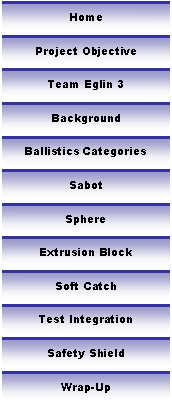
|
Extrusion Block-Design Generation/ Selection |
|
Keeping the scope of the component in mind, the team brainstormed ideas for the extrusion block. All the following designs are detailed in their respective section below.
Extrusion Block Decision Matrix The decision matrix used was composed of four categories, each with its own weight.
Machinability: This directly relates to the ease of fabrication. This includes the difficulty of the cuts necessary and how easy the material is cut. With a weight of 30%, this category is important because the test apparatus needs to be able to be machined. The design may require re-machining after multiple tests and the more difficult the machining process, the higher the cost to maintain the capability.
Durability: This category relates the extrusion block’s ability to be reused. This includes both the ability of the block to withstand multiple tests and the ease of re-machining/replacing broken sections of the testing block. The durability is most important at 40% because the block needs to either withstand many tests or have section that can be replaced easily.
Cost: The cost of the extrusion block will include the price of materials needed to construct the block. This has the least amount of weight (10%) because the price of the material is the only variable. The use of different materials can decrease the cost.
Ease of use: The ease of use is how easily the block can be assembled for each test. The greater number of parts increases the difficulty of setting up the experiment. This is weighted only 20% because the only design parameter that can be changed is the amount of parts and not the way the test is performed.
Each category is rated from 0 to 1, 0 being the worst and 1 being the best. Each cell is multiplied by its weight then added to the rest of the values of that row. The maximum total is equal to 1.
Conclusion
Design 3 was selected for development in the detail design phase. It scored the highest in the criteria that was selected. The information on very high strain rate is very limited and therefore the team is not able to accurately understand the ability of the material to withstand high shock pressure. The use of the inserts will provide the ability to test multiple hardened steels without re-machining the entire block. The inserts in the design do not have an extrusion channel which is an unwanted feature. The channel is where the photographing takes place and can not be done inside the block.
|




|
Copyright 2006-2007 Famu-Fsu College of Engineering . All Rights Reserved |
|
Design |
Machinability-30% |
Durability-40% |
Cost- 10% |
Ease of use-20% |
Total |
|
1 |
.6 |
.2 |
.3 |
.8 |
.45 |
|
2 |
.4 |
.2 |
.5 |
.6 |
.37 |
|
3 |
.5 |
.8 |
.8 |
.6 |
.67 |
|
4 |
.6 |
.8 |
.6 |
.2 |
.6 |